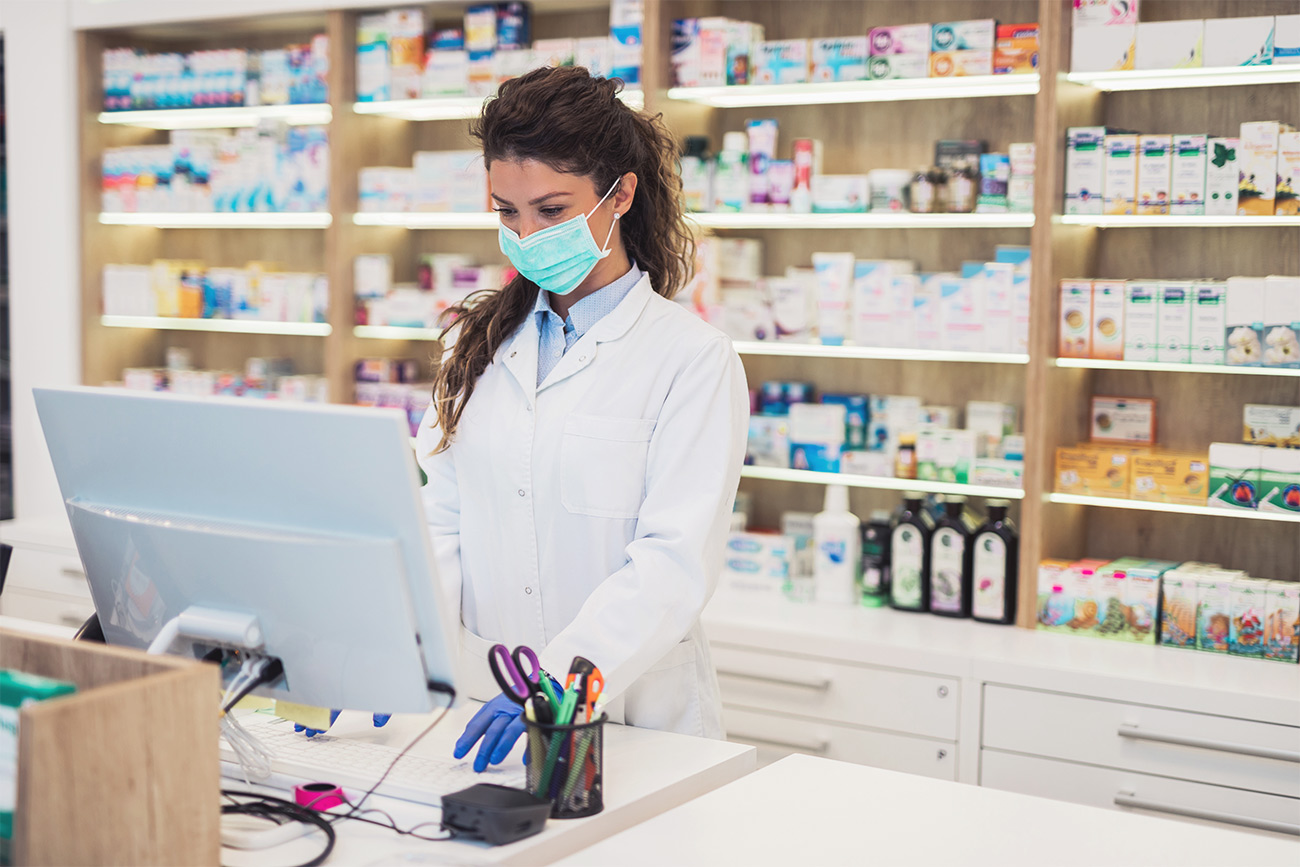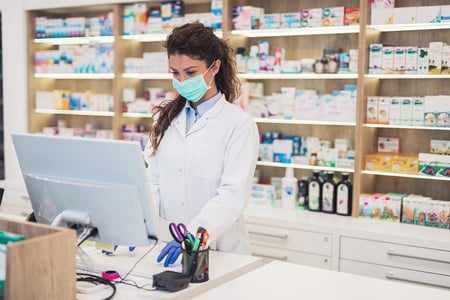
Five tips for improving your sterile compounding pharmacy's daily operations
 We originally published this article in March 2021 and have updated it to include additional resources for compliance and environmental monitoring.
We originally published this article in March 2021 and have updated it to include additional resources for compliance and environmental monitoring.
Keeping a sterile compounding pharmacy running efficiently requires proper planning, diligence, and consistency. Depending on your pharmacy’s size procurement staff, quality managers, pharmacists, technicians, supply chain personnel and owners may be included in operational decisions. Streamlining processes and workflows with standard operating procedures can help your pharmacy operate more efficiently.
Pharmacies must maintain an inventory of supplies, monitor air quality, schedule staffing, and provide a safe working environment while maintaining compliance with federal and state regulations. From donning bouffant caps to compounding drugs, following these five steps will help ensure your sterile compounding pharmacy to streamline operations and maximize profitability.
1. Plan ahead for compounding runs
Compounding runs may occur at regular and irregular intervals. Ensuring you have the correct inventory on hand as part of your production planning will guarantee a smoother and more efficient production run for compounding.
Determine how many sterile cleanroom gowns, gloves, agar plates, and testing kits are needed prior to production to ensure you do not run short. If a typical production run is scheduled two weeks in advance, strive to increase your scheduling to three or four weeks instead. Building in this extra cushion allows you to identify the required labor needed for the run and gives your buyers time to source or order supplies accordingly.
Once the required staff for the run has been identified you can determine their size requirements. By knowing which employees will be entering and exiting a clean room each day and the frequency, your buyers can order the correct quantity of PPE and disinfectants. Understanding how technicians use inventory, and in what quantities is an important part of planning. Likewise, knowing the drugs to be manufactured dictate what cleaning products will be required. Plan to keep a minimum of two weeks’ worth of surplus inventory on hand in the event of unforeseen events, such as a prolonged power outage or weather-related delay. Power loss leads to cleanroom pressure loss, which then requires a full breach cleaning and use of additional disinfectant products.
2. Keep Standard Operations Procedures current
Standard operating procedures (SOPs) for every compounding pharmacy process are required by the U.S. Food and Drug administration (FDA) and state boards to operate lawfully. Depending on the size of your pharmacy, SOPs should be location specific or station specific for every task, from gowning to mixing drugs. FDA and state boards inspectors confirm procedures onsite, looking for any SOP inconsistencies. For example, if a specific nitrile glove is unavailable due to a product shortage and technicians have been using a Polyisoprene glove instead, the SOP must include this temporary process change.
Pharmacies may build out their SOPs from scratch, use manufacturer SOPs, or incorporate both. Pharmacies should consider using manufacturer SOPs if the pharmacist is not comfortable (or lacks sufficient experience) writing them. Most pharmacy suppliers/manufacturers should not only be able to provide SOPs, but also provide SOP guidance and consultation. Using manufacturer SOPs exclusively does not guarantee your pharmacy will meet or exceed regulatory compliance, as interim and temporary process updates may be required due to product shortages.
Designate a head pharmacist, or manager, to review SOPs regularly – typically once a quarter. Provide employee training and education to ensure SOPs are followed and that updates are tracked. Regularly reviewing SOPs will help your team remain compliant.
USP offers free training courses, including one on Document and Reference Standards. These courses are an excellent resources to help start-up compounding pharmacies learn about compliance and build SOPs.
3. Validate processes to FDA standards
To remain legally compliant, pharmacy employees must stay current with industry standards. FDA and state boards use US Pharmacopeia (USP) guidelines 797 and 800. Changes in these regulatory standards and guidelines occur as needed, such as additional cleaning requirements, so it is important to sign up for alerts. The pharmacy manger should monitor for updates.
Process validation helps maintain compliance to FDA standards. The FDA offers Process Validation guidance and looks for consistency in the production of active pharmaceutical ingredients (APIs) and drug products. According to the FDA, process validation is necessary because quality cannot be assured by in-process and finished-product inspection or testing. To ensure consistency, pharmacies should continually make improvements and refinements to processes as needed and review regularly. For example, if pharmacies add hazardous compounding to production, gloves that meet the USP 800 standard must be sourced and used.
4. Automate packaging and filling
Automating your pharmacy’s packaging and filling improves the efficiency of pharmacy operations. A Journal of the American Pharmacists Association study proved about 30 seconds of time per prescription filled could be saved. Efficiency gains in each pharmacy will vary depending on automation equipment chosen and products being packaged or filled. However, automating your packaging processes improve reliability and helps move more products safely and efficiently out the door.
Installing automated vial filling machines increases product output without increasing staff. While automated filling machines carry an upfront cost, the vial production output increases often make the investment worthwhile. Adding clean room automation equipment helps mitigate human error and decreases the risk of contamination to a sterile product.
5. Monitor environmental performance
Monitor for viable and non-viable particulates per USP Chapter 797 Chapter 5, General Monitoring Requirements to maintain environmental quality in your cleanroom. Your pharmacy’s microbiological air and surface monitoring program must include viable impact volumetric airborne particulate sampling and surface sampling per. Testing for viable particles is done passively with settling plates and actively with air samplers. 
Use optical counters to test for non-viable particles, which might include material shed from a sterile cleanroom gown. Low and medium-risk level compounding areas should be tested monthly and high-risk level compounded areas should be tested weekly.
503(B) Outsourcing Facilities sell bulk compounds to meet contract requirements with hospitals and healthcare companies. They are required to continuously monitor viable and non-viable particle counts during compounding runs. 503(A) compounding pharmacies focus on patient-specific drug compounds and had not been required to run continuous viable and non-viable testing until the FDA updated the non-viable continuous monitoring regulations in 2018. By adding continuous non-viable testing to the process pharmacies have more current and actionable information that can be used to determine if a particulate or spore excursion is occurring or did occur during a compounding production run.
Your desire as a compounding pharmacy leader should be to maintain a safe and sterile cleanroom that meets all FDA and state operational requirements. Pharmacies that run at top efficiency plan for production, maintain up-to-date standard operational procedures, and regularly validate processes. Successful pharmacy leaders use automation where appropriate and continuously monitor the clean room environment for particulate or microbial excursions. Following these five recommended steps will help keep your pharmacy’s daily operations running smoothly and safely.
About DiNovo
Since 2013, DiNovo Pharmacy & Packaging Provisions has been a leader in delivering cleanroom consumables, disinfectants, medical devices, and cold chain shipping solutions to the compounding and specialty pharmacy marketplace. As an educational resource, coupled with top global manufacturer partnerships, DiNovo is able to help pharmacies drive efficiency, manage costs, and enhance compliance to help guide you through a constantly changing pharmacy marketplace.
.png?width=500&height=153&name=DiNovo%20Full%20Logo%20-%20Both%20Tags%20(500x153).png)